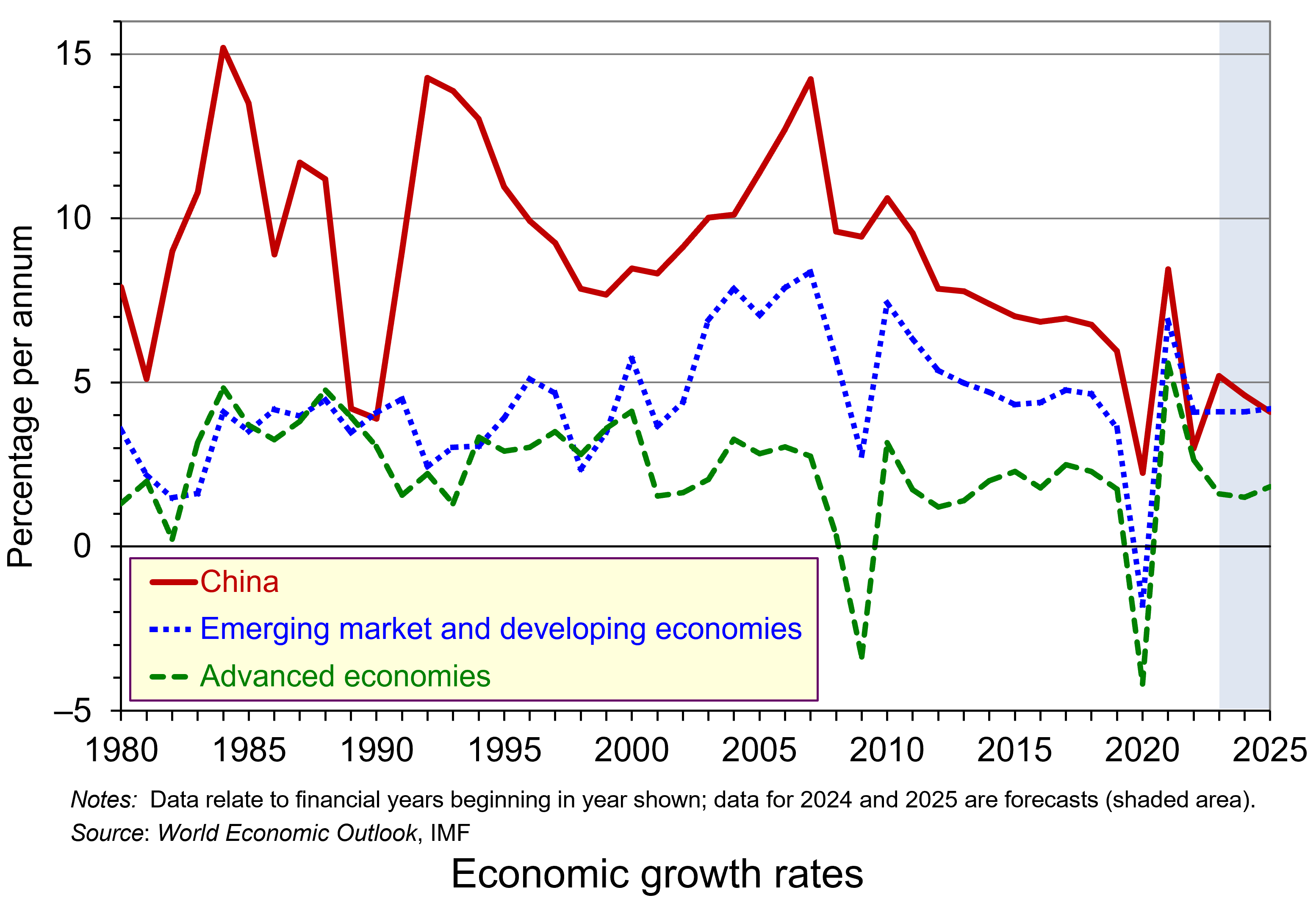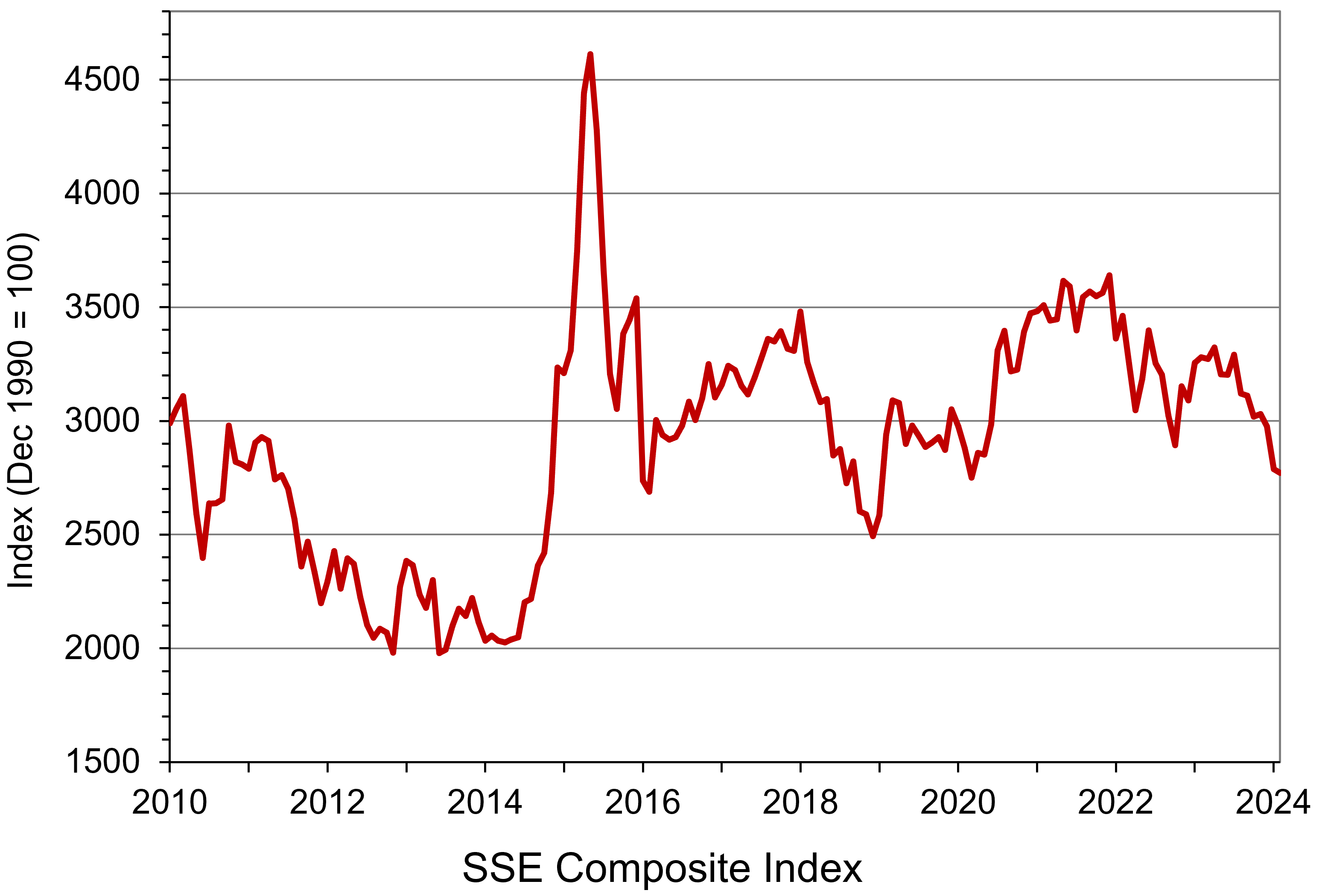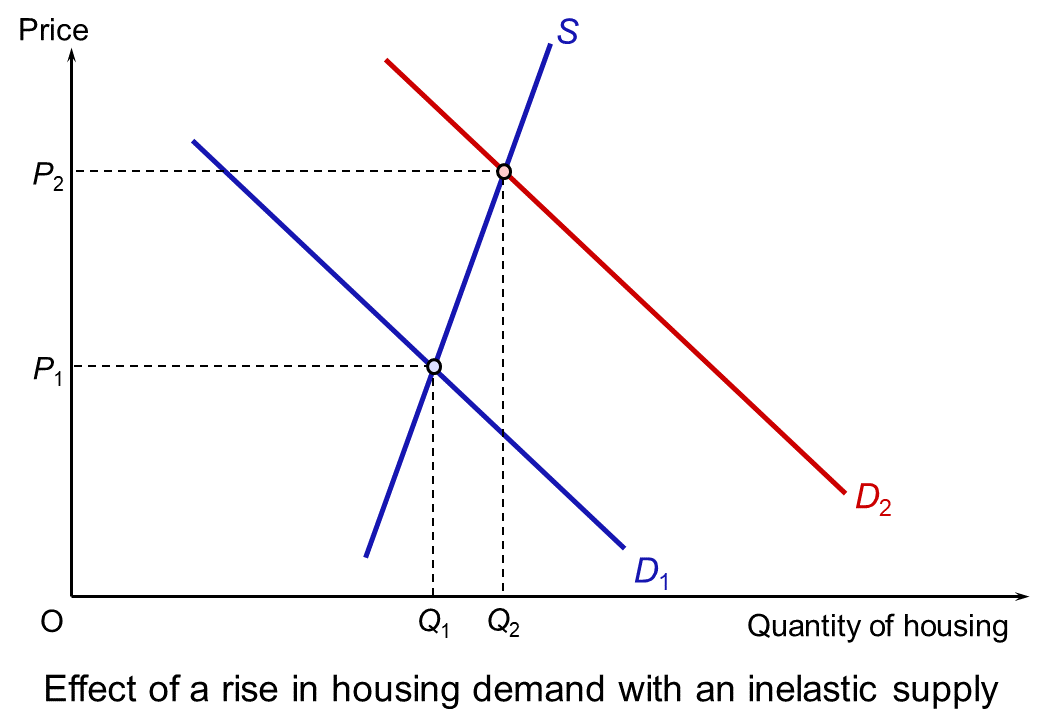 According to the IMF, Chinese GDP grew by 5.2% in 2023 and is predicted to grow by 4.6% this year. Such growth rates would be extremely welcome to most developed countries. UK growth in 2023 was a mere 0.5% and is forecast to be only 0.6% in 2024. Advanced economies as a whole only grew by 1.6% in 2023 and are forecast to grow by only 1.5% this year. Also, with the exception of India, the Philippines and Indonesia, which grew by 6.7%, 5.3% and 5.0% respectively in 2023 and are forecast to grow by 6.5%, 6.0% and 5.0% this year, Chinese growth also compares very favourably with other developing countries, which as a weighted average grew by 4.1% last year and are forecast to grow at the same rate this year.
According to the IMF, Chinese GDP grew by 5.2% in 2023 and is predicted to grow by 4.6% this year. Such growth rates would be extremely welcome to most developed countries. UK growth in 2023 was a mere 0.5% and is forecast to be only 0.6% in 2024. Advanced economies as a whole only grew by 1.6% in 2023 and are forecast to grow by only 1.5% this year. Also, with the exception of India, the Philippines and Indonesia, which grew by 6.7%, 5.3% and 5.0% respectively in 2023 and are forecast to grow by 6.5%, 6.0% and 5.0% this year, Chinese growth also compares very favourably with other developing countries, which as a weighted average grew by 4.1% last year and are forecast to grow at the same rate this year.
 But in the past, Chinese growth was much higher and was a major driver of global growth. Over the period 1980 to 2018, Chinese economic growth averaged 9.5% – more than twice the average rate of developing countries (4.5%) and nearly four times the average rate of advanced countries (2.4%) (see chart – click here for a PowerPoint of the chart).
But in the past, Chinese growth was much higher and was a major driver of global growth. Over the period 1980 to 2018, Chinese economic growth averaged 9.5% – more than twice the average rate of developing countries (4.5%) and nearly four times the average rate of advanced countries (2.4%) (see chart – click here for a PowerPoint of the chart).
Not only is Chinese growth now much lower, but it is set to decline further. The IMF forecasts that in 2025, Chinese growth will have fallen to 4.1% – below the forecast developing-country average of 4.2% and well below that of India (6.5%).
Causes of slowing Chinese growth
There are a number of factors that have come together to contribute to falling economic growth rates – growth rates that otherwise would have been expected to be considerably higher as the Chinese economy reopened after severe Covid lockdowns.
 Property market
Property market
China has experienced a property boom over the past 20 years years as the government has encouraged construction in residential blocks and in factories and offices. The sector has accounted for some 20% of economic activity. But for many years, demand outstripped supply as consumers chose to invest in property, partly because of a lack of attractive alternatives for their considerable savings and partly because property prices were expected to go on rising. This lead to speculation on the part of both buyers and property developers. Consumers rushed to buy property before prices rose further and property developers borrowed considerably to buy land, which local authorities encouraged, as it provided a valuable source of revenue.
But now there is considerable overcapacity in the sector and new building has declined over the past three years. According to the IMF:
Housing starts have fallen by more than 60 per cent relative to pre-pandemic levels, a historically rapid pace only seen in the largest housing busts in cross-country experience in the last three decades. Sales have fallen amid homebuyer concerns that developers lack sufficient financing to complete projects and that prices will decline in the future.
As a result, many property developers have become unviable. At the end of January, the Chinese property giant, Evergrande, was ordered to liquidate by a Hong Kong court, after the judge ruled that the company did not have a workable plan to restructure around $300bn of debt. Over 50 Chinese property developers have defaulted or missed payments since 2020. The liquidation of Evergrande and worries about the viability of other Chinese property developers is likely to send shockwaves around the Chinese property market and more widely around Chinese investment markets.
Overcapacity
Rapid investment over many years has led to a large rise in industrial capacity. This has outstripped demand. The problem could get worse as investment, including state investment, is diverted from the property sector to manufacturing, especially electric vehicles. But with domestic demand dampened, this could lead to increased dumping on international markets – something that could spark trade wars with the USA and other trading partners (see below). Worries about this in China are increasing as the possibility of a second Trump presidency looks more possible. The Chinese authorities are keen to expand aggregate demand to tackle this overcapacity.
Uncertainty
Consumer and investor confidence are low. This is leading to severe deflationary pressures. If consumers face a decline in the value of their property, this wealth effect could further constrain their spending. This will, in turn, dampen industrial investment.
Uncertainty is beginning to affect foreign companies based in China. Many foreign companies are now making a loss in China or are at best breaking even. This could lead to disinvestment and add to deflationary pressures.
The Chinese stock market and policy responses
 Lack of confidence in the Chinese economy is reflected in falling share prices. The Shanghai SSE Composite Index (an index of all stocks traded on the Shanghai Stock Exchange) has fallen dramatically in recent months. From a high of 3703 in September 2021, it had fallen to 2702 on 5 Feb 2024 – a fall of 27%. It is now below the level at the beginning of 2010 (see chart: click here for a PowerPoint). On 5 February alone, some 1800 stocks fell by over 10% in Shanghai and Shenzhen. People were sensing a rout and investors expressed their frustration and anger on social media, including the social media account of the US Embassy. The next day, the authorities intervened and bought large quantities of key stocks. China’s sovereign wealth fund announced that it would increase its purchase of shares to support the country’s stock markets. The SSE Composite rose 4.1% on 6 February and the Shenzhen Component Index rose 6.2%.
Lack of confidence in the Chinese economy is reflected in falling share prices. The Shanghai SSE Composite Index (an index of all stocks traded on the Shanghai Stock Exchange) has fallen dramatically in recent months. From a high of 3703 in September 2021, it had fallen to 2702 on 5 Feb 2024 – a fall of 27%. It is now below the level at the beginning of 2010 (see chart: click here for a PowerPoint). On 5 February alone, some 1800 stocks fell by over 10% in Shanghai and Shenzhen. People were sensing a rout and investors expressed their frustration and anger on social media, including the social media account of the US Embassy. The next day, the authorities intervened and bought large quantities of key stocks. China’s sovereign wealth fund announced that it would increase its purchase of shares to support the country’s stock markets. The SSE Composite rose 4.1% on 6 February and the Shenzhen Component Index rose 6.2%.
However, the rally eased as investors waited to see what more fundamental measures the authorities would take to support the stock markets and the economy more generally. Policies are needed to boost the wider economy and encourage a growth in consumer and business confidence.
Interest rates have been cut four times since the beginning of 2022, when the prime loan rate was cut from 3.85% to 3.7%. The last cut was from 3.55% to 3.45% in August 2023. But this has been insufficient to provide the necessary boost to aggregate demand. Further cuts in interest rates are possible and the government has said that it will use proactive fiscal and effective monetary policy in response to the languishing economy. However, government debt is already high, which limits the room for expansionary fiscal policy, and consumers are highly risk averse and have a high propensity to save.
Graduate unemployment
 China has seen investment in education as an important means of increasing human capital and growth. But with a slowing economy, there are are more young people graduating each year than there are graduate jobs available. Official data show that for the group aged 16–24, the unemployment rate was 14.9% in December. This compares with an overall urban unemployment rate of 5.1%. Many graduates are forced to take non-graduate jobs and graduate jobs are being offered at reduced salaries. This will have a further dampening effect on aggregate demand.
China has seen investment in education as an important means of increasing human capital and growth. But with a slowing economy, there are are more young people graduating each year than there are graduate jobs available. Official data show that for the group aged 16–24, the unemployment rate was 14.9% in December. This compares with an overall urban unemployment rate of 5.1%. Many graduates are forced to take non-graduate jobs and graduate jobs are being offered at reduced salaries. This will have a further dampening effect on aggregate demand.
Demographics
China’s one-child policy, which it pursued from 1980 to 2016, plus improved health and social care leading to greater longevity, has led to an ageing population and a shrinking workforce. This is despite recent increases in unemployment in the 16–24 age group. The greater the ratio of dependants to workers, the greater the brake on growth as taxes and savings are increasingly used to provide various forms of support.
Effects on the rest of the world
China has been a major driver of world economic growth. With a slowing Chinese economy, this will provide less stimulus to growth in other countries. Many multinational companies, including chip makers, cosmetics companies and chemical companies, earn considerable revenue from China. For example, the USA exports over $190 billion of goods and services to China and these support over 1 million jobs in the USA. A slowdown in China will have repercussions for many companies around the world.
There is also the concern that Chinese manufacturers may dump products on world markets at less than average (total) cost to shift stock and keep production up. This could undermine industry in many countries and could initiate a protectionist response. Already Donald Trump is talking about imposing a 10% tariff on most imported goods if he is elected again in November. Such tariffs could be considerably higher on imports from China. If Joe Biden is re-elected, he too may impose tariffs on Chinese goods if they are thought to be unfairly subsidised. US (and possibly EU) tariffs on Chinese goods could lead to a similar response from China, resulting in a trade war – a negative sum game.
Videos
Articles
- IMF Predicts China Economy Slowing Over Next Four Years
Voice of America, Evie Steele (2/2/24)
- China’s Real Estate Sector: Managing the Medium-Term Slowdown
IMF News, Henry Hoyle and Sonali Jain-Chandra (2/2/24)
- China braced for largest human migration on earth amid bleak economic backdrop
ITV News, Debi Edward (4/2/24)
- China’s property giant Evergrande ordered to liquidate as debt talks fail
Aljazeera (29/1/24)
- China’s overcapacity a challenge that is ‘here to stay’, says US chamber
Financial Times, Joe Leahy (1/2/24)
- China needs to learn lessons from 1990s Japan
Financial Times, Gillian Tett (1/2/24)
- The Trump factor is looming over China’s markets
Financial Times, Katie Martin (2/2/24)
- China’s many systemic problems dominate its outlook for 2024
The Guardian, George Magnus (1/1/24)
- China youth unemployment will stay elevated in 2024, but EIU warns economic impact will linger
CNBC, Clement Tan (25/1/24)
- Don’t count on a soft landing for the world economy – turbulence is ahead
The Guardian, Kenneth Rogoff (2/2/24)
- As falling stocks draw criticism in China, censors struggle to keep up
Washington Post, Lily Kuo (6/2/24)
- China’s doom loop: a dramatically smaller (and older) population could create a devastating global slowdown
The Conversation, Jose Caballero (12/2/24)
- China: why the country’s economy has hit a wall – and what it plans to do about it
The Conversation, Hong Bo (19/3/24)
- Confronting inflation and low growth
OECD Economic Outlook Interim Report (September 2023) (see especially Box 1)
Questions
- Why is China experiencing slowing growth and is growth likely to pick up over the next five years?
- How does the situation in China today compare with that in Japan 30 years ago?
- What policies could the Chinese government pursue to stimulate economic growth?
- What policies were enacted towards China during the Trump presidency from 2017 to 2020?
- Would you advise the Chinese central bank to cut interest rates further? Explain.
- Should China introduce generous child support for families, no matter the number of children?
 China has been an economic powerhouse in recent decades – a powerhouse that has helped to drive the world economy through trade and both inward and outward investment. At the same time, its low-priced exports have helped to dampen world inflation. But is all this changing? Is China, to use President Biden’s words, a ‘ticking time bomb’?
China has been an economic powerhouse in recent decades – a powerhouse that has helped to drive the world economy through trade and both inward and outward investment. At the same time, its low-priced exports have helped to dampen world inflation. But is all this changing? Is China, to use President Biden’s words, a ‘ticking time bomb’?
China’s economic growth rate is slowing, with the quarterly growth in GDP falling from 2.2% in Q1 this year to 0.8% in Q2. Even though public-sector investment rose by 8.1% in the first six months of this year, private-sector investment fell by 0.2%, reflecting waning business confidence. And manufacturing output declined in August. But, despite slowing growth, the Chinese government is unlikely to use expansionary fiscal policy because of worries about growing public-sector debt.
The property market
 One of the biggest worries for the Chinese economy is the property market. The annual rate of property investment fell by 20.6% in June this year and new home prices fell by 0.2% in July (compared with June). The annual rate of price increase for new homes was negative throughout 2022, being as low as minus 1.6% in November 2022; it was minus 0.1% in the year to July 2023, putting new-home prices at 2.4% below their August 2021 level. However, these are official statistics. According to the Japan Times article linked below, which reports Bloomberg evidence, property agents and private data providers report much bigger falls, with existing home prices falling by at least 15% in many cities.
One of the biggest worries for the Chinese economy is the property market. The annual rate of property investment fell by 20.6% in June this year and new home prices fell by 0.2% in July (compared with June). The annual rate of price increase for new homes was negative throughout 2022, being as low as minus 1.6% in November 2022; it was minus 0.1% in the year to July 2023, putting new-home prices at 2.4% below their August 2021 level. However, these are official statistics. According to the Japan Times article linked below, which reports Bloomberg evidence, property agents and private data providers report much bigger falls, with existing home prices falling by at least 15% in many cities.
Falling home prices have made home-owners poorer and this wealth effect acts as a brake on spending. The result is that, unlike in many Western countries, there has been no post-pandemic bounce back in spending. There has also been a dampening effect on local authority spending. During the property boom they financed a proportion of their spending by selling land to property developers. That source of revenue has now largely dried up. And as public-sector revenues have been constrained, so this has constrained infrastructure spending – a major source of growth in China.
The government, however, has been unwilling to compensate for this by encouraging private investment and has tightened regulation of the financial sector. The result has been a decline in new jobs and a rise in unemployment, especially among graduates, where new white collar jobs in urban areas are declining. According to the BBC News article linked below, “In July, figures showed a record 21.3% of jobseekers between the ages of 16 and 25 were out of work”.
Deflation
 The fall in demand has caused consumer prices to fall. In the year to July 2023, they fell by 0.3%. Even though core inflation is still positive (0.8%), the likelihood of price reductions in the near future discourages spending as people hold back, waiting for prices to fall further. This further dampens the economy. This is a problem that was experienced in Japan over many years.
The fall in demand has caused consumer prices to fall. In the year to July 2023, they fell by 0.3%. Even though core inflation is still positive (0.8%), the likelihood of price reductions in the near future discourages spending as people hold back, waiting for prices to fall further. This further dampens the economy. This is a problem that was experienced in Japan over many years.
Despite slowing economic growth, Chinese annual growth in GDP for 2023 is still expected to be around 4.5% – much lower than the average rate for 9.5% from 1991 to 2019, but considerably higher than the average of 1.1% forecast for 2023 for the G7 countries. Nevertheless, China’s exports fell by 14.5% in the year to July 2023 and imports fell by 12.5%. The fall in imports represents a fall in exports to China from the rest of the world and hence a fall in injections to the rest-of-the-world economy. Currently China’s role as a powerhouse of the world has gone into reverse.
Articles
Questions
- Using PowerPoint or Excel, plot the growth rate of Chinese real GDP, real exports and real imports from 1990 to 2024 (using forecasts for 2023 and 2024). Use data from the IMF’s World Economic Outlook database. Comment on the figures.
- Explain the wealth effect from falling home prices.
- Why may official figures understate the magnitude of home price deflation?
- Explain the foreign trade multiplier and its relevance to other countries when the volume of Chinese imports changes. What determines the size of this multiplier for a specific country?
- How does the nature of the political system in China affect the likely policy response to the problems identified in this blog?
- Is there any good news for the rest of the world from the slowdown in the Chinese economy?
 For the majority of people, a house (or flat) is the most valuable thing they will ever own.
For the majority of people, a house (or flat) is the most valuable thing they will ever own.
It is important to understand the role that house prices play in the economy and how much of an impact they have.
The Bank of England monitors changes in the housing market to assess the risks to the financial system and the wider economy. The housing market employs large numbers of people in construction, sales, furniture and fittings, and accounts for a sizeable percentage of the value of GDP. The market is closely linked to consumer spending and therefore is a crucially important sector of the economy.
The concepts of supply and demand can be applied to understand house price changes and the impacts on the economy.
What is the housing market?
The housing market brings together different stakeholders, such as homeowners who are selling their properties, people seeking to buy a property, renters, investors who buy and sell properties solely for investment purposes, contractors, renovators and estate agents, who act as facilitators in the process of buying or selling a property.
In the UK, two-thirds of households own the property in which they live, and the remaining third of households are renters, split fairly equally between private and social renting. We can thus divide people into:
- Homeowners – either outright owners or with a mortgage;
- Private renters – people renting from private landlords;
- Social renters – people renting from local authorities and housing associations.
There are many determinants of demand and supply in the housing market, many of which are related to demographic factors. Such factors include the size of the market, rate of marriages, divorces, and deaths. However, factors such as income, availability of credit, interest rates and consumer preferences are also important.
Why is the housing market important for the economy?
 Changes in the housing market are always given such importance due to the relationship house prices have with consumer spending. Changes in house prices and the number of sales affect how much money people have to spend. Given that household spending accounts for two-thirds of Britain’s total economic activity, any changes in consumption is likely to have a major impact on the wider economy. Observing the housing market helps us to assess the overall demand for goods and services.
Changes in the housing market are always given such importance due to the relationship house prices have with consumer spending. Changes in house prices and the number of sales affect how much money people have to spend. Given that household spending accounts for two-thirds of Britain’s total economic activity, any changes in consumption is likely to have a major impact on the wider economy. Observing the housing market helps us to assess the overall demand for goods and services.
When house prices increase, those consumers who own their own homes have now become better off as their houses are worth more. This ‘wealth effect’ increases the confidence of homeowners, which in turn increases consumption. Some of these homeowners will decide to acquire additional borrowing against the value of their home. The borrowing is then spent in the economy on goods and services, thereby increasing aggregate demand and GDP.
However, when house prices decline, homeowners lose confidence as their home is now worth less than before. This becomes a major issue if prices have decreased enough to make their house worth less than the remainder of the unpaid mortgage – known as ‘negative equity’. Homeowners will therefore reduce their consumption and will be less likely to undertake any new borrowing.
The vast majority of homeowners will have taken out a mortgage in order to purchase their home. Mortgages are the largest source of debt for households in the UK. More than 70% of household borrowing is mortgage debt. Half of all homeowners who live in the house they own are still paying off their mortgage. Therefore, households might suddenly hold back on their spending during times of uncertainty because they start to worry about repaying their debts. This has a knock-on effect on the rest of economy, and a small problem can suddenly become a big one.
In addition to affecting overall household spending, the buying and selling of houses also affects the economy directly. Housing investment is a small but unpredictable part of total output in the economy. There are two different ways in which the buying and selling of houses impacts GDP.
 The first is when a new build is purchased. This directly contributes to GDP through the investment in the land to build the house on, the purchase of materials and the creation of jobs. Once the homeowners move in they also contribute to the local economy: i.e. shopping at local shops.
The first is when a new build is purchased. This directly contributes to GDP through the investment in the land to build the house on, the purchase of materials and the creation of jobs. Once the homeowners move in they also contribute to the local economy: i.e. shopping at local shops.
The second is when an existing home is bought or sold. The purchase of an existing home does not have the same impact on GDP. However, it does still contribute to GDP: i.e. from estate agents’ and solicitors’ fees and removal costs to the purchase of new furniture.
Why house prices change: demand and supply
Demand: the demand for housing can be defined as the quantity of properties that homebuyers are willing and able to buy at a given price in a given time period. Factors affecting the demand for housing include:
- Real incomes: If real incomes increase the demand for housing increases due to a rise in the standard of living.
- The cost of a mortgage: If there is a rise in interest rates in the economy, mortgage interest rates are likely to rise too. This makes the cost of financing a loan more expensive and therefore will see a decline in demand.
- Availability of credit: The more lending banks and building societies are willing to provide, the more people will borrow and spend on housing and hence the higher house prices will be.
- Economic growth: When the economy is in the recovery and boom stages of the business cycle, wages rise. This will increase the demand for houses.
- Population: When the population increases or if there is an increase in single-person households, demand for housing increases.
- Employment/unemployment: The higher the level of unemployment in an economy, the less people will able to afford housing.
- Confidence: If consumers feel optimistic about the future state of the economy, they will be more likely to go ahead with purchasing a house, thereby increasing demand. House prices tend to rise if people expect to be richer in the future.
Supply: The supply of housing can be defined as the flow of properties available at a given price in a given time period. The supply of housing includes both new-build homes and existing properties. Factors affecting the supply for housing include:
- Costs of production: The higher the cost of production, the fewer houses are built, reducing the supply of housese coming to the market. Example of costs include: labour costs, land for development and building materials.
- Government policy: If the government increases taxation and/or reduces subsidies for new house developments, there will be fewer new houses built.
- Number of construction companies: Depending on their objectives, the more construction companies there are, the more likely there is to be an increase in the supply of housing. The construction industry accounts for around 7% of UK GDP.
- Technology and innovation: With improved technology and innovation in the construction industry, houses become cheaper and easier to build, thus increasing the supply.
- Government spending on building new social housing: The government has the ability to influence the supply of housing by increasing spending on new social housing.
Price elasticity of supply
 The supply of new housing in the short run is price inelastic. The main reason for this is the time it takes to build a new home. The production of a house can take many months, from the planning process to the project’s completion. Supply also relies on access to a skilled labour force and the availability of certain construction materials.
The supply of new housing in the short run is price inelastic. The main reason for this is the time it takes to build a new home. The production of a house can take many months, from the planning process to the project’s completion. Supply also relies on access to a skilled labour force and the availability of certain construction materials.
Because of the inelastic supply, any changes in demand are likely to have a significant effect on price. This is illustrated by the diagram, which shows a larger proportionate increase in price than quantity when demand increases from D1 to D2.
The current UK housing market
Despite the current economic climate and the effects of the lockdown restrictions on consumers, house prices have increased, and sales have now resumed. Rightmove, which advertises 95% of homes for sale, states that the housing market has seen its busiest month in more than 10 years in July. During the summer, the housing market usually sees a lull in activity. However, since the easing of lockdown, there has been a flurry of activity from buyers and sellers. Since July 2019, house prices have increased by 1.7%, according to the Nationwide Building Society.
 London estate agency, Hamptons, states that homeowners are now bringing forward their moving plans as the experience of lockdown has encouraged them to seek more space. The mortgage market is also very favourable right now in terms of interest rates, and rental demand is continuing to surge across the UK.
London estate agency, Hamptons, states that homeowners are now bringing forward their moving plans as the experience of lockdown has encouraged them to seek more space. The mortgage market is also very favourable right now in terms of interest rates, and rental demand is continuing to surge across the UK.
The increase in activity in the market has also been helped by the announcement of a stamp duty ‘holiday’ until March 2021. This sees the threshold above which stamp duty is paid rising from £125 000 to £500 000. Estate agency, Savills, has also seen an increase in the number of new buyers registering with its service, more than double the number registered in July 2019. It is thought that, along with the tax savings from stamp duty, people’s experiences in lockdown have made them evaluate their current living space and reconsider their housing needs.
However, given the that the economy is experiencing its deepest recession on record, there is concern about just how long the market can resist the economic forces pulling prices down.
Historically, a drop in house prices has been both a cause and a consequence of economic recessions. During the 2008 financial crisis, house prices fell by about 30%. As previously mentioned, for the majority of people, a house is the most valuable thing they will ever own and therefore consumers are extremely interested in its value. Consumer confidence is one of the key factors affecting the demand for housing. If consumers feel pessimistic about the future state of the economy, they will be less likely to go ahead with purchasing a house, thereby decreasing demand. Britain’s Office for Budget Responsibility, the country’s fiscal watchdog, forecasts that during this downturn prices will fall 5% this year and 11% in 2021.
Various government schemes put in place to help during lockdown are starting to come to an end. The main one – the furlough scheme, which replaced 80% of eligible workers’ incomes – comes to an end in October. It is forecast that labour market conditions will weaken significantly in the quarters ahead, with unemployment predicted to rise for the rest of the year. If these predictions materialise, it would likely dampen housing activity once again.
Conclusion
Fluctuations in house prices and transactions tend to amplify the volatility of the economic cycle. Therefore, it is crucial that we understand what influences such changes. Understanding how supply and demand factors influence the housing market can enable key stakeholders to make better predictions about future activity and plan accordingly. The current market has seen a growth since the easing of restrictions but there is concern that this has been powered by pent-up demand. Therefore, the outlook for house prices is uncertain and the full effects of an economic downturn are yet to be realised.
Articles
Questions
- Explain why the supply of housing is inelastic in the short-term.
- Given that the elasticity of housing supply in the UK is low, what policies could be introduced to ensure that house building is more responsive to changes in market demand?
- If unemployment does increase as predicted, explain what impact this would have on the demand in the housing market and house prices? Use a supply and demand diagram to aid your answer.
- Explain how changes in house prices affect the government’s key macroeconomic objectives.
 According to the IMF, Chinese GDP grew by 5.2% in 2023 and is predicted to grow by 4.6% this year. Such growth rates would be extremely welcome to most developed countries. UK growth in 2023 was a mere 0.5% and is forecast to be only 0.6% in 2024. Advanced economies as a whole only grew by 1.6% in 2023 and are forecast to grow by only 1.5% this year. Also, with the exception of India, the Philippines and Indonesia, which grew by 6.7%, 5.3% and 5.0% respectively in 2023 and are forecast to grow by 6.5%, 6.0% and 5.0% this year, Chinese growth also compares very favourably with other developing countries, which as a weighted average grew by 4.1% last year and are forecast to grow at the same rate this year.
According to the IMF, Chinese GDP grew by 5.2% in 2023 and is predicted to grow by 4.6% this year. Such growth rates would be extremely welcome to most developed countries. UK growth in 2023 was a mere 0.5% and is forecast to be only 0.6% in 2024. Advanced economies as a whole only grew by 1.6% in 2023 and are forecast to grow by only 1.5% this year. Also, with the exception of India, the Philippines and Indonesia, which grew by 6.7%, 5.3% and 5.0% respectively in 2023 and are forecast to grow by 6.5%, 6.0% and 5.0% this year, Chinese growth also compares very favourably with other developing countries, which as a weighted average grew by 4.1% last year and are forecast to grow at the same rate this year. But in the past, Chinese growth was much higher and was a major driver of global growth. Over the period 1980 to 2018, Chinese economic growth averaged 9.5% – more than twice the average rate of developing countries (4.5%) and nearly four times the average rate of advanced countries (2.4%) (see chart – click here for a PowerPoint of the chart).
But in the past, Chinese growth was much higher and was a major driver of global growth. Over the period 1980 to 2018, Chinese economic growth averaged 9.5% – more than twice the average rate of developing countries (4.5%) and nearly four times the average rate of advanced countries (2.4%) (see chart – click here for a PowerPoint of the chart). Property market
Property market Lack of confidence in the Chinese economy is reflected in falling share prices. The Shanghai SSE Composite Index (an index of all stocks traded on the Shanghai Stock Exchange) has fallen dramatically in recent months. From a high of 3703 in September 2021, it had fallen to 2702 on 5 Feb 2024 – a fall of 27%. It is now below the level at the beginning of 2010 (see chart: click here for a PowerPoint). On 5 February alone, some 1800 stocks fell by over 10% in Shanghai and Shenzhen. People were sensing a rout and investors expressed their frustration and anger on social media, including the social media account of the US Embassy. The next day, the authorities intervened and bought large quantities of key stocks. China’s sovereign wealth fund announced that it would increase its purchase of shares to support the country’s stock markets. The SSE Composite rose 4.1% on 6 February and the Shenzhen Component Index rose 6.2%.
Lack of confidence in the Chinese economy is reflected in falling share prices. The Shanghai SSE Composite Index (an index of all stocks traded on the Shanghai Stock Exchange) has fallen dramatically in recent months. From a high of 3703 in September 2021, it had fallen to 2702 on 5 Feb 2024 – a fall of 27%. It is now below the level at the beginning of 2010 (see chart: click here for a PowerPoint). On 5 February alone, some 1800 stocks fell by over 10% in Shanghai and Shenzhen. People were sensing a rout and investors expressed their frustration and anger on social media, including the social media account of the US Embassy. The next day, the authorities intervened and bought large quantities of key stocks. China’s sovereign wealth fund announced that it would increase its purchase of shares to support the country’s stock markets. The SSE Composite rose 4.1% on 6 February and the Shenzhen Component Index rose 6.2%.  China has seen investment in education as an important means of increasing human capital and growth. But with a slowing economy, there are are more young people graduating each year than there are graduate jobs available. Official data show that for the group aged 16–24, the unemployment rate was 14.9% in December. This compares with an overall urban unemployment rate of 5.1%. Many graduates are forced to take non-graduate jobs and graduate jobs are being offered at reduced salaries. This will have a further dampening effect on aggregate demand.
China has seen investment in education as an important means of increasing human capital and growth. But with a slowing economy, there are are more young people graduating each year than there are graduate jobs available. Official data show that for the group aged 16–24, the unemployment rate was 14.9% in December. This compares with an overall urban unemployment rate of 5.1%. Many graduates are forced to take non-graduate jobs and graduate jobs are being offered at reduced salaries. This will have a further dampening effect on aggregate demand. Evergrande liquidation: What’s behind China’s biggest corporate fail ever
Evergrande liquidation: What’s behind China’s biggest corporate fail ever Is China’s economy in serious trouble?
Is China’s economy in serious trouble? China’s stock market bounce is ‘short-term exuberance’, says Longview Global’s Dewardric McNeal
China’s stock market bounce is ‘short-term exuberance’, says Longview Global’s Dewardric McNeal China has been an economic powerhouse in recent decades – a powerhouse that has helped to drive the world economy through trade and both inward and outward investment. At the same time, its low-priced exports have helped to dampen world inflation. But is all this changing? Is China, to use President Biden’s words, a ‘ticking time bomb’?
China has been an economic powerhouse in recent decades – a powerhouse that has helped to drive the world economy through trade and both inward and outward investment. At the same time, its low-priced exports have helped to dampen world inflation. But is all this changing? Is China, to use President Biden’s words, a ‘ticking time bomb’? One of the biggest worries for the Chinese economy is the property market. The annual rate of property investment fell by 20.6% in June this year and
One of the biggest worries for the Chinese economy is the property market. The annual rate of property investment fell by 20.6% in June this year and  The fall in demand has caused consumer prices to fall. In the year to July 2023, they fell by 0.3%. Even though core inflation is still positive (0.8%), the likelihood of price reductions in the near future discourages spending as people hold back, waiting for prices to fall further. This further dampens the economy. This is a problem that was experienced in Japan over many years.
The fall in demand has caused consumer prices to fall. In the year to July 2023, they fell by 0.3%. Even though core inflation is still positive (0.8%), the likelihood of price reductions in the near future discourages spending as people hold back, waiting for prices to fall further. This further dampens the economy. This is a problem that was experienced in Japan over many years. For the majority of people, a house (or flat) is the most valuable thing they will ever own.
For the majority of people, a house (or flat) is the most valuable thing they will ever own. Changes in the housing market are always given such importance due to the relationship house prices have with consumer spending. Changes in house prices and the number of sales affect how much money people have to spend. Given that household spending accounts for two-thirds of Britain’s total economic activity, any changes in consumption is likely to have a major impact on the wider economy. Observing the housing market helps us to assess the overall demand for goods and services.
Changes in the housing market are always given such importance due to the relationship house prices have with consumer spending. Changes in house prices and the number of sales affect how much money people have to spend. Given that household spending accounts for two-thirds of Britain’s total economic activity, any changes in consumption is likely to have a major impact on the wider economy. Observing the housing market helps us to assess the overall demand for goods and services. The first is when a new build is purchased. This directly contributes to GDP through the investment in the land to build the house on, the purchase of materials and the creation of jobs. Once the homeowners move in they also contribute to the local economy: i.e. shopping at local shops.
The first is when a new build is purchased. This directly contributes to GDP through the investment in the land to build the house on, the purchase of materials and the creation of jobs. Once the homeowners move in they also contribute to the local economy: i.e. shopping at local shops.  The supply of new housing in the short run is price inelastic. The main reason for this is the time it takes to build a new home. The production of a house can take many months, from the planning process to the project’s completion. Supply also relies on access to a skilled labour force and the availability of certain construction materials.
The supply of new housing in the short run is price inelastic. The main reason for this is the time it takes to build a new home. The production of a house can take many months, from the planning process to the project’s completion. Supply also relies on access to a skilled labour force and the availability of certain construction materials.  London estate agency, Hamptons, states that homeowners are now bringing forward their moving plans as the experience of lockdown has encouraged them to seek more space. The mortgage market is also very favourable right now in terms of interest rates, and rental demand is continuing to surge across the UK.
London estate agency, Hamptons, states that homeowners are now bringing forward their moving plans as the experience of lockdown has encouraged them to seek more space. The mortgage market is also very favourable right now in terms of interest rates, and rental demand is continuing to surge across the UK.